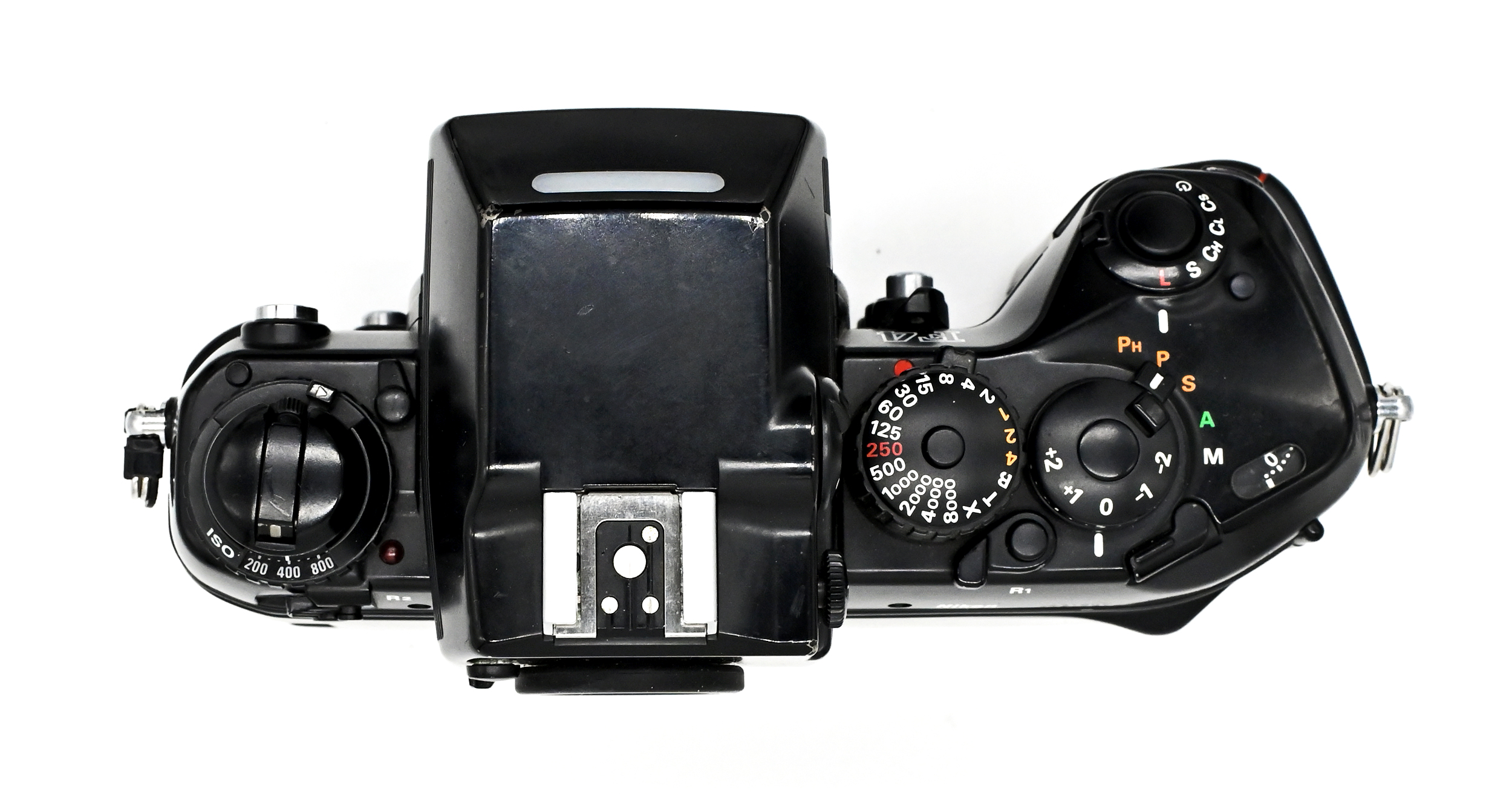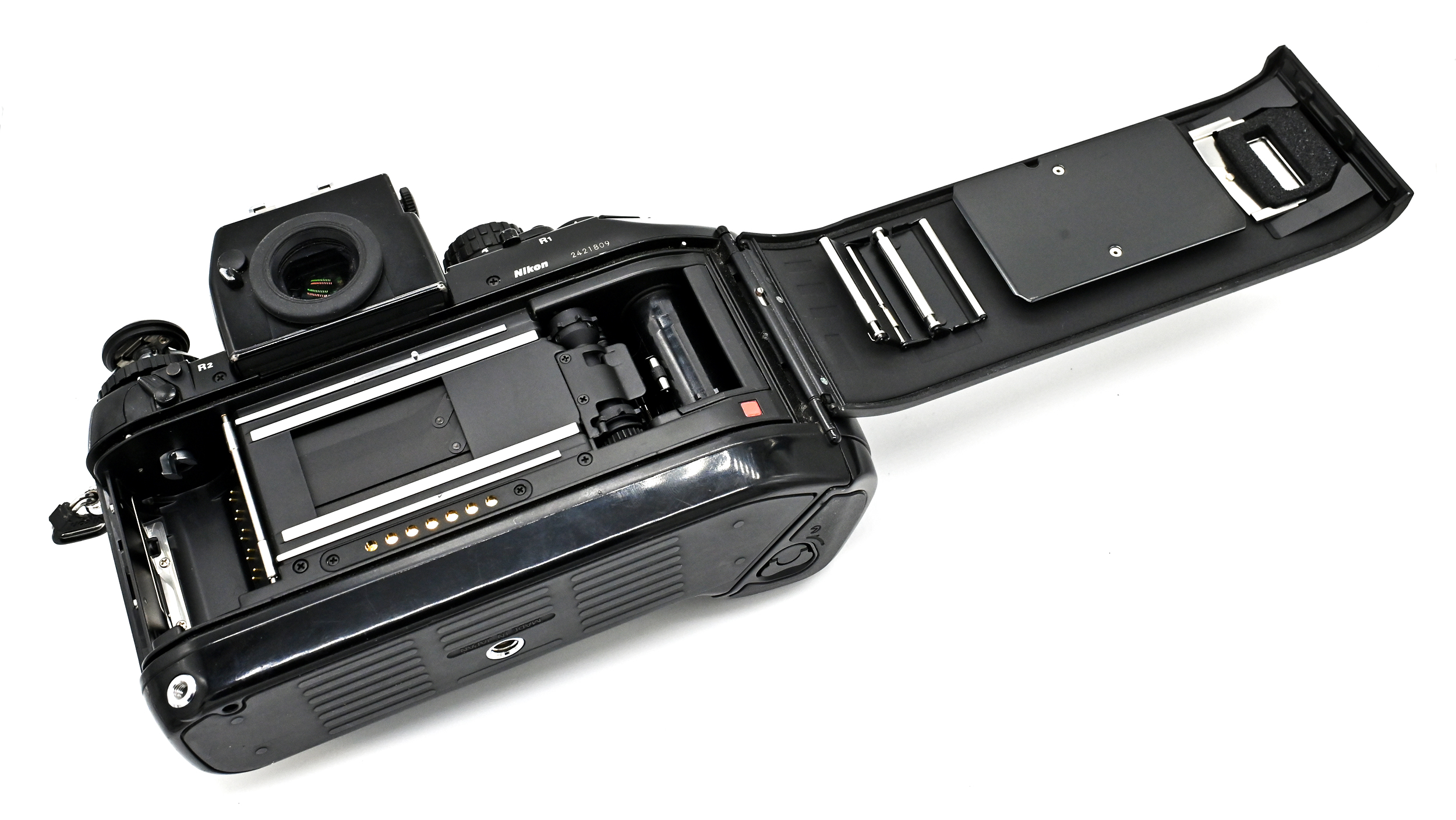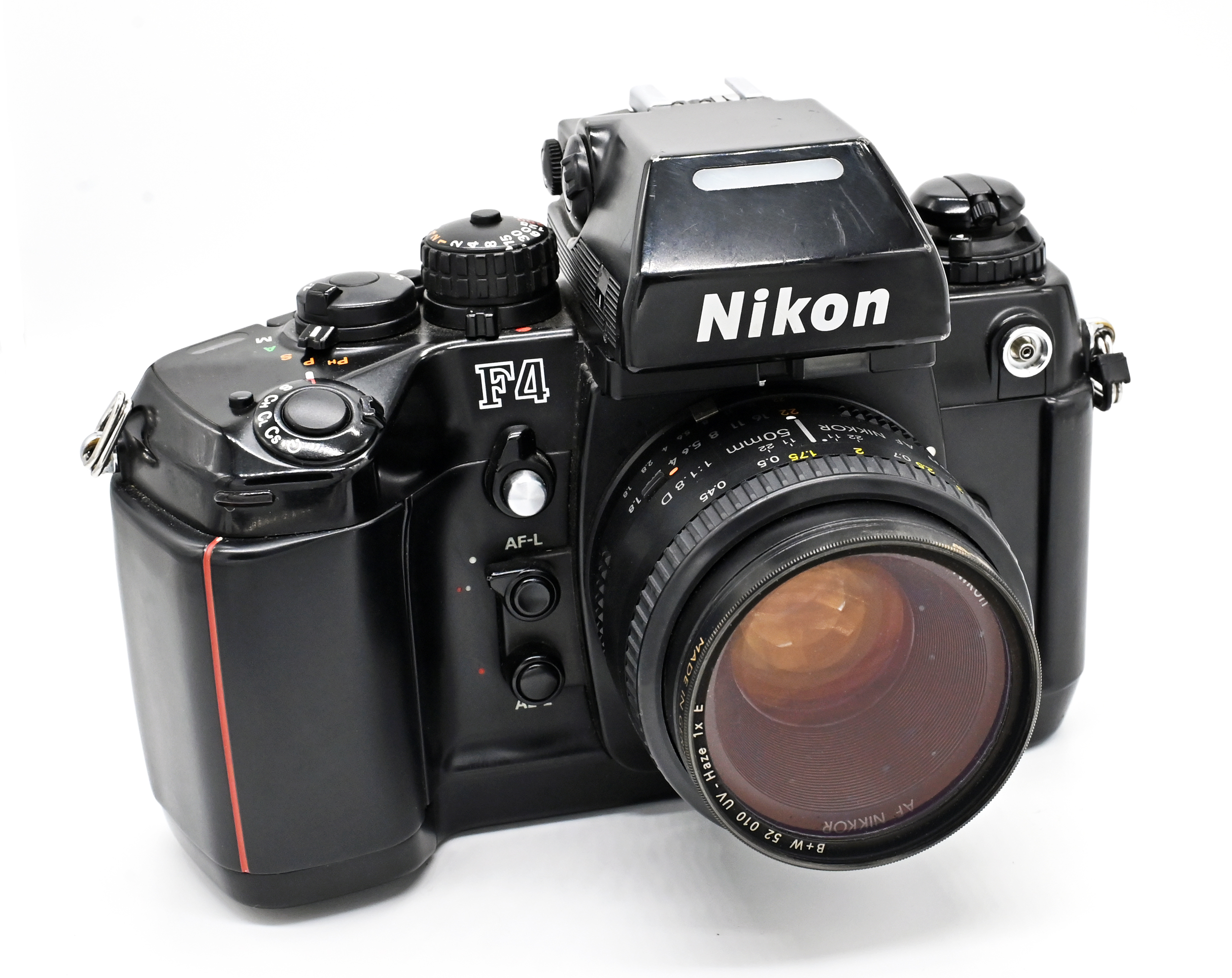
In the history of Nikon 35mm film SLR cameras, none arguably was more revolutionary than the 1988 F4. The 1959 Nikon F ushered in the film SLR era. The 1971 F2 improved upon the concept. The 1980 F3’s stunningly bright finder, rugged reliability, and 5.5 frames per second motor drive set the bar for photojournalism during the Reagan-Thatcher era. The F4 significantly changed the game in its own way.
By the early 1980s, the SLR game was changing fast. Everyone foresaw that the future was autofocus, and the race was on. In 1982, Canon introduced the consumer-oriented AL-1 with a primitive “phase detection autofocus” that permitted the use of manual focus lenses in an “assist” mode. In 1983, Nikon responded with the F3AF, a version of the F3 that used a special finder that permitted the autofocusing of specially-designed 80mm and 200mm lenses. Still, this primitive foray was arguably ahead of most other manufacturers at the time. However, it was the 1985 Minolta Maxxum 7000 that beat both Nikon and Canon to the punch with an LCD shooting menu, an integrated autofocus mechanism, and a built-in motor drive.
Nikon responded in 1986 with the N2020 (the F-501 in other markets). Although directed at the consumer market, the N2020 was built upon the prior 1985 N2000 non-AF chassis, had a fairly advanced for the time phase detection autofocus, and a 2.5 FPS integrated motor drive (but no auto rewind). A motor inside the camera drove the autofocus mechanism (a so-called “screw drive” mechanism). Today, such motors are inside the lenses themselves. No shooting menu LCDs, just switches and dials. However, Nikon’s first-generation autofocus system found in the N2020 was slow, noisy, and not entirely reliable in low-light conditions.

Canon seriously upped the ante in March 1987 with the introduction of the EOS 650 and then the slightly more advanced 620 later that year. Canon developed a completely new lens mount (the “EF”) not natively-compatible with any of its previous-generation manual focus lenses (the “FD” mount). With fast autofocus, matrix TTL metering, LCD menus, and a 3 frames per second motor drive, the 620/650 arguably became the most advanced SLR in the world.
For its part, Nikon decided that instead of creating a new lens mount for the autofocus generation, it would create AF lenses in F mount — which meant that new AF bodies could use the older manual focus lenses, and the manual focus bodies could use the AF lenses (in manual focus mode only, of course). Nikon’s decision to stick with the F mount, unlike Canon and Minolta that “ditched” their legacy lenses in their new systems, certainly endeared itself with many users. In 1986, in connection with the launch of the N2020, Nikon’s “AF” lens series emerged. In 1992, Nikon updated these lenses to “AF-D” specification to assist with TTL flash control.

The F4 is one of the most intelligently-designed SLRs of all time. Unlike the LCD menus of Canon and Minolta, the F4 is all dials and switches. The F4 was a complete system camera with every possible accessory the professional market could ask for: motor drives, focusing screens, interchangeable finders, data backs, battery modules, underwater housings, and on and on. The F4 upgraded the autofocus module found in the N2020 and provided a fairly advanced TTL flash system with auto day fill flash capability, multiple metering modes (including matrix metering), auto film rewind, multiple single and continuous shooting modes, and an integrated 4 frames-per-second motor drive. The “F4s” version included a vertical grip and a larger battery pack (the MD-21) and allowed up to 5.7 FPS, and the F4e had an even larger battery pack (the MD-23). Nikon also made an MD-22 that permitted the use of an external power source. I am not going to endeavor to detail the equipment and technical specifications of the F4 system, but you can get a good sense here.

Although the F4 was made to complement Nikon’s contemporary line of late-1980s AF lenses, it still both autofocuses and retains “program” and “shutter priority” functionality with modern AF-S lenses. It will focus-assist with Ai and Ai-S lenses.
The F4’s electronics, now over 30 years old, have held up pretty well with very few, if any, endemic mechanical or electronic problems. The only problem of note is that a few of DP-20 finders have had their LCD displays start to leak. Manufacturers of the 1980s warned people of this possibility with all LCD-equipped cameras. However, the average DP-20 is still working just fine today.
Using the F4 In Real Life
The Nikon F4 is a rather hefty machine, even bulkier with the larger battery pack/motor drive combos (the F4s and F4e). The primary selling point is the extremely bright viewfinder — really blowing away any non-professional film SLR. The F4’s aluminum alloy body is also tough as nails. If you are, like me, someone invested in a variety of 35mm film machines, the F4 is a go-to in circumstances that require that you get the shot — in focus and properly exposed.

The F4 is a such a sophisticated camera that it would be impossible to run through the entirety of its functionality. Other than fast-moving sports or other similar subjects, where it has been definitively surpassed, there is no other job that the F4 and its dedicated accessories cannot tackle.
For Ai, Ai-S, AF, AF-D lenses, the F4 can operate in a complete dummy Program mode, or if you prefer Aperture-Priority, Shutter Speed-Priority, or Manual modes. One of the most ingenious and useful features of the F4 is the “Program High” mode. This mode automatically tells the camera to set a wide aperture for maximum depth of field and loss of motion blur. Program High also assists with shooting AF-S lenses where no manual aperture control on the F4 is possible. Although you cannot set the exact aperture on these later lenses, you can tell the F4 to “prefer” depth of field + higher shutter speeds, so achieving the same basic result.
In practice, I find using the stock focusing screen and matrix metering fine for most settings. Without the auxiliary built-in finder light, I do have a hard time seeing the LCD readout in DP-20 finder. In daylight, a SB-20 and SB-30 Speedlight flashes perform well in auto fill-flash mode (perhaps a tad bit overexposed). The built-in motor drive is remarkable and suitable for most purposes. Focus tracking on fast moving subjects is not good and nearly useless. In the past, I have used the MD-21 battery pack which contains a separate shutter release for when holding the camera vertically. But for everyday shooting, its added bulk normally adds little to the experience.
Conclusion
Although your grandparent’s F/F2 may hold sentimental value, your acquisition of a former pro photographer’s beat-up but working F3HP may be a great conversation piece, and the FA, FG, EM, and FM2 are all super cute, none of them beat the F4 on any metric other than size and weight. While the F5, F100, and F6 all moved the ball significantly forward, especially with their faster auto focus modules and increased lens compatibility (i.e. with “G” lenses), the F4 has everything most photographers would need in a camera. With F4 bodies being offered for so cheap these days, they are one of the great deals in 35mm film photography today.
Thank you for a good review. I have yet to work with the Nikon F4 but would love to try. I have used the FM2, the F3, the F5 and the F100 for many years. I think it is very important to realise that the F100 is built to nowhere near the standard of the F5. The F100 is often presented as a “mini F5” but it really isn’t. From its plastic latch film door, its lack of sealing less dampened action, the biggest difference in my experience is far less reliable electronics. I have been through two F100’s and its a poster child camera for where specs look amazing but if you look beyond them the F5 is a far greater camera.
Thanks for the comment! I agree that there is no question that the F5 is an overall “better” machine than the F4. I have only briefly used an F100, and agree that it is not built to be a “true” professional camera, but its autofocus is much faster than the F4. The F4s are just so cheap these days that it is a good time to pick one up if you always wanted to try one.
Thank you for this review sir. The F4 is a fantastic camera and one of my favorites. I have the Fed and many others. I looked at the F100, but it really didn’t measure up and seemed to have sealing issues. Besides, I love how the Drs looks in comparison. I also have the F5 and love it as well. Can’t really say which one I like better because the both feel like you have a strong, professional camera in your hands. On assignments to Russia I take both along with the Hasselblad 500 CM. I also carry an FE as back-up. I might recommend you do a review on the FA as it too was a very inventive and somewhat unique camera. I am seriously looking to get one also. I shoot mostly digital and just put them on a disc. Then I have all the ‘digital’ photos from my favorite cameras and do any PP on the computer. Keep up the good work and do more reviews. Thank you again sir.